The Ford Model K
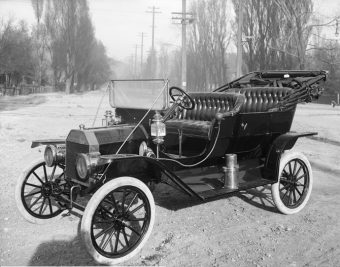 We’ve all heard of the Ford Model T—but we rarely hear about the earlier automobiles in the whole “model-letter” scheme. So hear you go…
We’ve all heard of the Ford Model T—but we rarely hear about the earlier automobiles in the whole “model-letter” scheme. So hear you go…
ALPHABET CITY
In 1908, the Ford Motor Company, founded by Henry Ford just five years earlier, released its first Ford Model T—and the world has never been the same. The Model T was the first car that ordinary people could afford, and is regarded by automobile historians as the car that ushered in the Automobile Age (and killed the then extremely popular electric car). From 1908 until production ended in 1927, more than 16 million Model Ts were sold worldwide. No other car model ever sold as well…until 1972, when it was finally surpassed by the VW Beetle.
But the Model T’s great success overshadows all the models that came before it—all of them based on previous alphabet letters. Did Henry Ford make nineteen earlier models before the Model T—one for each letter before “T”? No. Most were experimental and never made it to production. But eight did.
MODEL A (1903–04): The Ford Motor Company’s first car. It consisted of little more than a frame with an upholstered bench seat mounted on top of it. (A rear bench seat compartment was optional.) There was no front compartment, no hood (the engine was under the seat), and nothing resembling a windshield or dashboard—the steering wheel simply stuck up out of the floor in front of the bench. Top speed: 28 mph. Cost: $750 (about $20,300 today). Color: red (only). About 1,700 were sold before production stopped in 1904—which was enough to keep Ford going. (Note: The name “Model A” was recycled in 1927 and used for the car that replaced the Model T.)
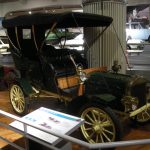 MODEL B (1904–05): This was a touring car, and much closer to the modern car configuration. It had two bench seats and came with doors—although only rear doors (the front seat had open access). The engine was located in its own compartment in the front of the car, under a hood and behind a radiator. The Model B was a luxury car, with polished wood, brass fittings and trim, came with leather seats and a canopy roof, and even had gas-powered headlights (although they were optional and cost extra). Top speed: 40 mph. Cost: $2,000. A total of about 500 Model Bs were sold.
MODEL B (1904–05): This was a touring car, and much closer to the modern car configuration. It had two bench seats and came with doors—although only rear doors (the front seat had open access). The engine was located in its own compartment in the front of the car, under a hood and behind a radiator. The Model B was a luxury car, with polished wood, brass fittings and trim, came with leather seats and a canopy roof, and even had gas-powered headlights (although they were optional and cost extra). Top speed: 40 mph. Cost: $2,000. A total of about 500 Model Bs were sold.
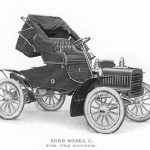 MODEL C (1904–05): This model was simply an updated version of the Model A. The engine was still under the front seat, but the Model C had a front compartment and hood anyway—that’s where the gas tank was located. The engine was also slightly larger, giving it a top speed of about 38 mph. Cost: $850. About 800 were sold before the Model C was discontinued in 1905.
MODEL C (1904–05): This model was simply an updated version of the Model A. The engine was still under the front seat, but the Model C had a front compartment and hood anyway—that’s where the gas tank was located. The engine was also slightly larger, giving it a top speed of about 38 mph. Cost: $850. About 800 were sold before the Model C was discontinued in 1905.
Special option: You could buy a Model C with a Model A engine—in which case it was called a Model AC.
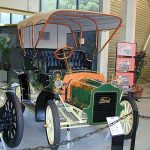 MODEL F (1905–06): An update of the Model C. The engine was still under the front seat, the gas tank was under the hood, it still had no front doors, but it was larger and longer, and the rear seat was now standard. And it had “running boards”—narrow steps located below the doors to make it easier to get into the vehicle—the first Ford to have them.
MODEL F (1905–06): An update of the Model C. The engine was still under the front seat, the gas tank was under the hood, it still had no front doors, but it was larger and longer, and the rear seat was now standard. And it had “running boards”—narrow steps located below the doors to make it easier to get into the vehicle—the first Ford to have them.
Cost: $1,000. About 1,000 were made.
MODEL K (1906–08):
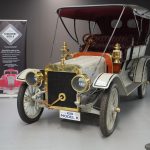 The Model K was big. It had a wheel-base—the distance between front and rear wheels—of 114 inches. (By comparison, the Model B’s was just 92 inches, and the Model A’s was 72 inches). It was also Ford’s first car with a 6-cylinder engine (earlier models had either 2 or 4 cylinders). Like the Model B, it was flashy, and intended for wealthy customers. Cost: $2,500 (about $65,000 in today’s money). Its two-year run was Ford’s longest yet—but only 950 models were sold. Ford would not make another 6-cylinder car for 35 years and turned his full focus to making very unluxurious automobiles.
The Model K was big. It had a wheel-base—the distance between front and rear wheels—of 114 inches. (By comparison, the Model B’s was just 92 inches, and the Model A’s was 72 inches). It was also Ford’s first car with a 6-cylinder engine (earlier models had either 2 or 4 cylinders). Like the Model B, it was flashy, and intended for wealthy customers. Cost: $2,500 (about $65,000 in today’s money). Its two-year run was Ford’s longest yet—but only 950 models were sold. Ford would not make another 6-cylinder car for 35 years and turned his full focus to making very unluxurious automobiles.
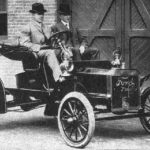 MODEL N (1906–08): The simple Model N was a sign of things to come for the Ford Motor Company. A successor of the A, C, and F models, the Model N came in only one color (maroon). It had only one bench seat, a small 4-cylinder engine capable of a top speed of about 40 mph, and no running boards. It was a plain car for plain people—and at a cost of just $500 (about $13,500 today), more than 7,000 of those people snapped them up in just two years.
MODEL N (1906–08): The simple Model N was a sign of things to come for the Ford Motor Company. A successor of the A, C, and F models, the Model N came in only one color (maroon). It had only one bench seat, a small 4-cylinder engine capable of a top speed of about 40 mph, and no running boards. It was a plain car for plain people—and at a cost of just $500 (about $13,500 today), more than 7,000 of those people snapped them up in just two years.
MODEL R (1907): Drivers loved the simple Model N, but some people wanted a bit more—hence the Model R. It was basically a slightly larger Model N, with running boards, stylized fenders, and a few other improvements. Cost: $750. More than 2,500 of them were sold in just six months.
MODEL S (1907–09): The Model S was another gussied-up Model N, this time with a fancier fender and running board configurations, and an option for a fold-down, single-person mother-in-law seat, or “rumble seat,” in the rear. Cost: $700. About 3,750 sold. More importantly, during the run of the Model S—the Model T was released. And the rest…is car history.
SPARE PARTS
- Ford’s very first motor vehicle wasn’t a letter-model car at all—it was his Quadricycle. Ford built it—engine and all—in a shed in his yard over a period of two years, finishing it in 1896, seven years before he launched the Ford Motor Company. The Quadricycle consisted of four bicycle wheels mounted to a simple frame, with a wooden box as a seat and rear wheels powered by an ethanol engine via a chain. Ford sold the Quadricycle for $200 and later built two more. (The original Quadricycle can be seen today in the Henry Ford Museum in Dearborn, Michigan.)
- The Model T came in several different styles during its long run, including roadster, four-door sedan, station wagon, and even as a pickup truck for a couple of years (from 1925 to 1927). They all had 4-cylinder engines and an average top speed of around 45 mph. The cheapest models cost just $260 (about $7,000 today)—all the way into the 1920s.
- The first person to own a Ford Motor Company car: Ernst Pfennig, a dentist from Chicago. He bought the first Model A ever produced on July 23, 1903.
- In 1905, the Ford Delivery Car was released—a Model C with an enclosed compartment behind the driver’s seat. It was a flop, and only about 12 were made. Why are we telling you this? Because some automobile literature refers to this vehicle as the Ford “Model E,” even though Ford listed it only as the “Delivery Car.”
- Through the early 1920s, the low-cost, bare-bones Model T dominated the automobile market. By the mid-’20s, other car companies had begun using Ford’s mass-production techniques and were offering what Ford considered “cosmetic luxuries” as standard equipment. But despite a dropoff in sales and against the advice of his son, Edsel, Henry Ford steadfastly refused to change the Model T. In 1926, he finally relented, allowing Edsel to develop a new model, called the Model A. Yet when the Model A was released in 1927, the elder Ford took all the credit. In its four years of production, more than 4.8 million Model As were sold.
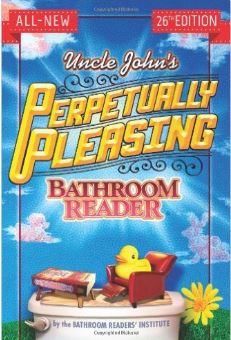 This article is reprinted with permission from Uncle John’s Perpetually Pleasing Bathroom Reader. Open up to any page and you may find an interesting origin (like the origin of the snowglobe) or a piece of obscure history (like the true story of the man who tried to repeal the law of gravity). You’ll also find weird news, urban legends, brain teasers, classic riddles, bizarre headlines, and of course, the incredible factoids at the bottom of each page.
This article is reprinted with permission from Uncle John’s Perpetually Pleasing Bathroom Reader. Open up to any page and you may find an interesting origin (like the origin of the snowglobe) or a piece of obscure history (like the true story of the man who tried to repeal the law of gravity). You’ll also find weird news, urban legends, brain teasers, classic riddles, bizarre headlines, and of course, the incredible factoids at the bottom of each page.
Since 1987, the Bathroom Readers’ Institute has led the movement to stand up for those who sit down and read in the bathroom (and everywhere else for that matter). With more than 15 million books in print, the Uncle John’s Bathroom Reader series is the longest-running, most popular series of its kind in the world.
If you like Today I Found Out, I guarantee you’ll love the Bathroom Reader Institute’s books, so check them out!
| Share the Knowledge! |
|





The model A Henry Ford First production car.
The second Model A Edsel Ford first production car.
That’s why the repeat. Different designers.